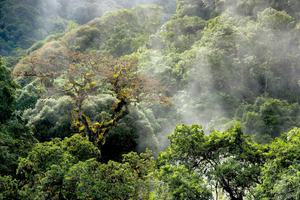On many summer days, trees, shrubs, and grasses across the New York metro area soak up as much carbon dioxide as is generated by all cars, buses, and trucks, according to new research.
For the study, researchers used aerial radar imagery to map the city in six-inch parcels, which allowed them to pinpoint small patches of greenery in densely built neighborhoods — modest backyard gardens, shrubbery growing in vacant lots, and individual trees dotting city sidewalks. Previous research has focused on larger green spaces, such as parks, but these areas cover only around 10 percent of New York. The new study accounts for the rest of the landscape as well.
“Most people have assumed that New York City is just a grey box,” Roísín Commane, a Columbia University researcher and coauthor of the paper, said in a statement. “But just because there’s a concrete sidewalk somewhere doesn’t mean there’s not also a tree that’s shading it.”
Greenery in Brooklyn's Prospect Heights neighborhood. Pink denotes buildings; purple denotes paved surfaces; dark green denotes trees; and light green denotes shrubs or grasses. Every pixel represents a 6-inch square. Wei et al.
Scientists determined that tree canopies cover some 22 percent of New York, while shrubs and grasses cover another 12 percent. They estimated the total amount of carbon dioxide taken up by plants in the summer, when New York is at its most green, and compared it with data on local carbon dioxide levels gathered from instruments taking measurements on a continuous basis.
Looking at the summer of 2018, researchers found that carbon dioxide levels ramped up in the morning as the city came to life, and then fell later in the day as plants went to work. Vegetation absorbed up to 40 percent of New York’s afternoon emissions and often completely offset emissions from traffic. The findings were published in the journal Environmental Research Letters.
“There is a lot more greenery than we thought, and that’s what drives our conclusion,” Dandan Wei, a postdoctoral researcher at Columbia and lead author of the study, said in a statement. “This tells us that the ecosystem matters in New York City, and if it matters here, it probably matters everywhere else.”




